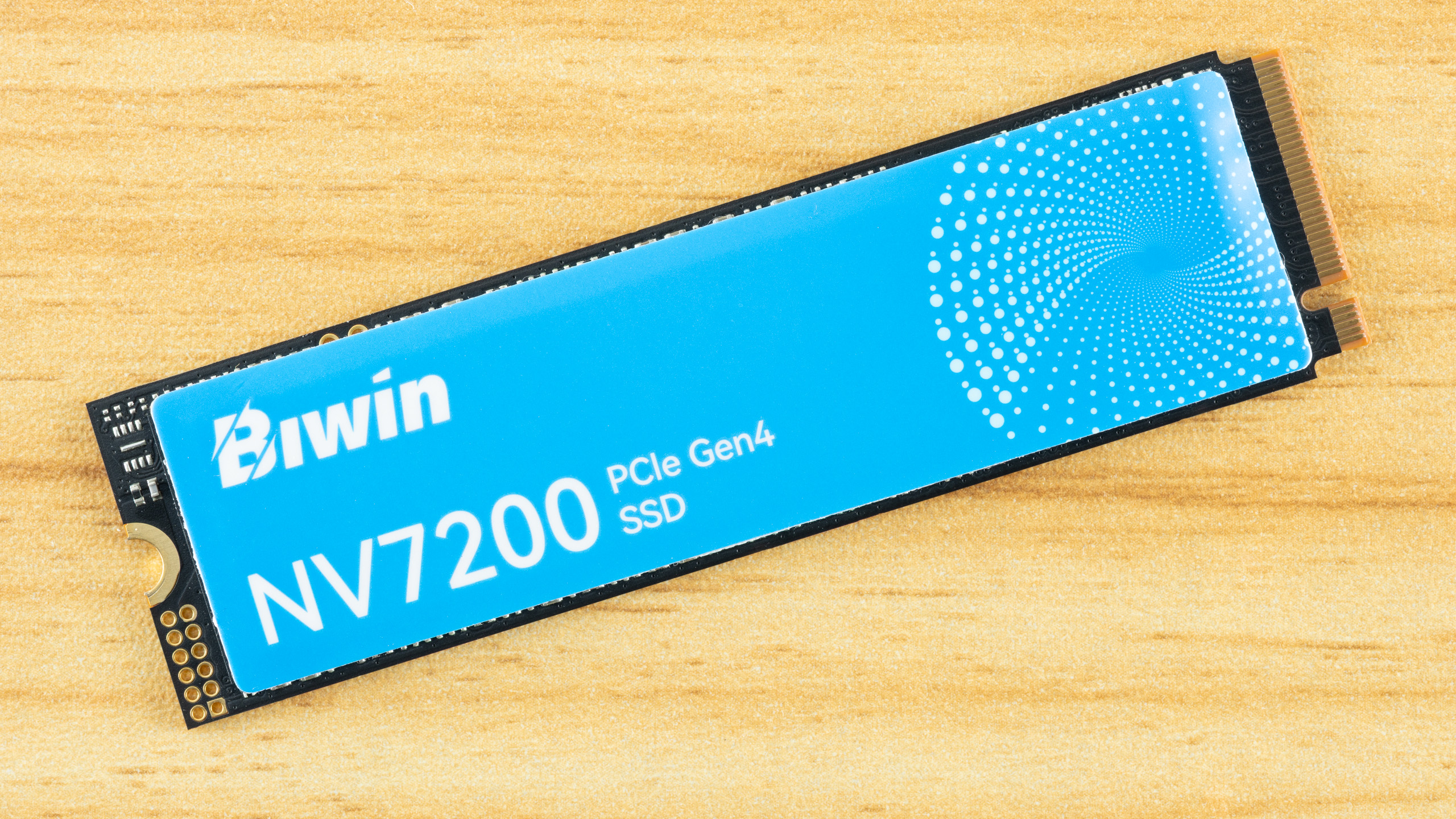Why you can trust Tom's Hardware
Comparison Products
We’re not going to give the NV7200 an easy fight, but we also don’t think putting it up against a high-end Gen 5 drive like the SanDisk WD Black SN8100 would give you useful information. We’re focusing on PCIe 4.0 drives within the budget range. There are a few groups of drives we need to look at for this.
The first is newer, QLC-based drives that can and will outperform the NV7200 in at least some cases. The two primary contenders are the Crucial P310 and the SanDisk WD Blue SN5100, and we’re looking at the former right now because it’s most likely to compete on price. The Blue SN5100 has so far not been sufficiently less expensive than the TLC-based SanDisk WD Black SN7100, which is going to be an equal or better drive in pretty much every benchmark. The second group would include drives with the same hardware, such as the TeamGroup MP44Q, HP FX700, and Acer FA200. The NV7200 is currently more available and affordable than these, and in fact, Biwin makes the FX700 and FA200. We still want to see if there are any differences.
The third group includes budget drives that may or may not have TLC flash or perform worse than expected with TLC. This would include the Klevv CRAS C925 and the Kingston NV3. The former brand acts as a type of low-end drive from SK hynix, which can make it interesting at the right price. The latter drive needs no introduction as Kingston is well-known for its budget NV series. Its biggest issue is that the hardware on it can change, and in fact, our TLC-based review sample is likely sold with QLC these days. The next group has TLC-based drives that do perform as expected, like the Corsair MP600 Elite and, arguably, we could have thrown in the Lexar NM790 and its ilk into this category as well. The problem here is that, for everyday activities, these perform about the same as QLC-based alternatives like the NV7200.
We lastly look at older budget drives that can come with QLC, like the Crucial P3 Plus, or TLC, like the WD Black SN770. For the most part, these drives have run their race and are only pickups on rare discounts. The TeamGroup MP44L would also fall into this category, but it and drives like it are not using set hardware. The controller and flash can — and will — change from drive to drive, and given the current market squeeze, it’s best to avoid them.
Trace Testing — 3DMark Storage Benchmark
Built for gamers, 3DMark’s Storage Benchmark focuses on real-world gaming performance. Each round in this benchmark stresses storage based on gaming activities including loading games, saving progress, installing game files, and recording gameplay video streams. Future gaming benchmarks will be DirectStorage-inclusive and we also include notes about which drives may be future-proofed.
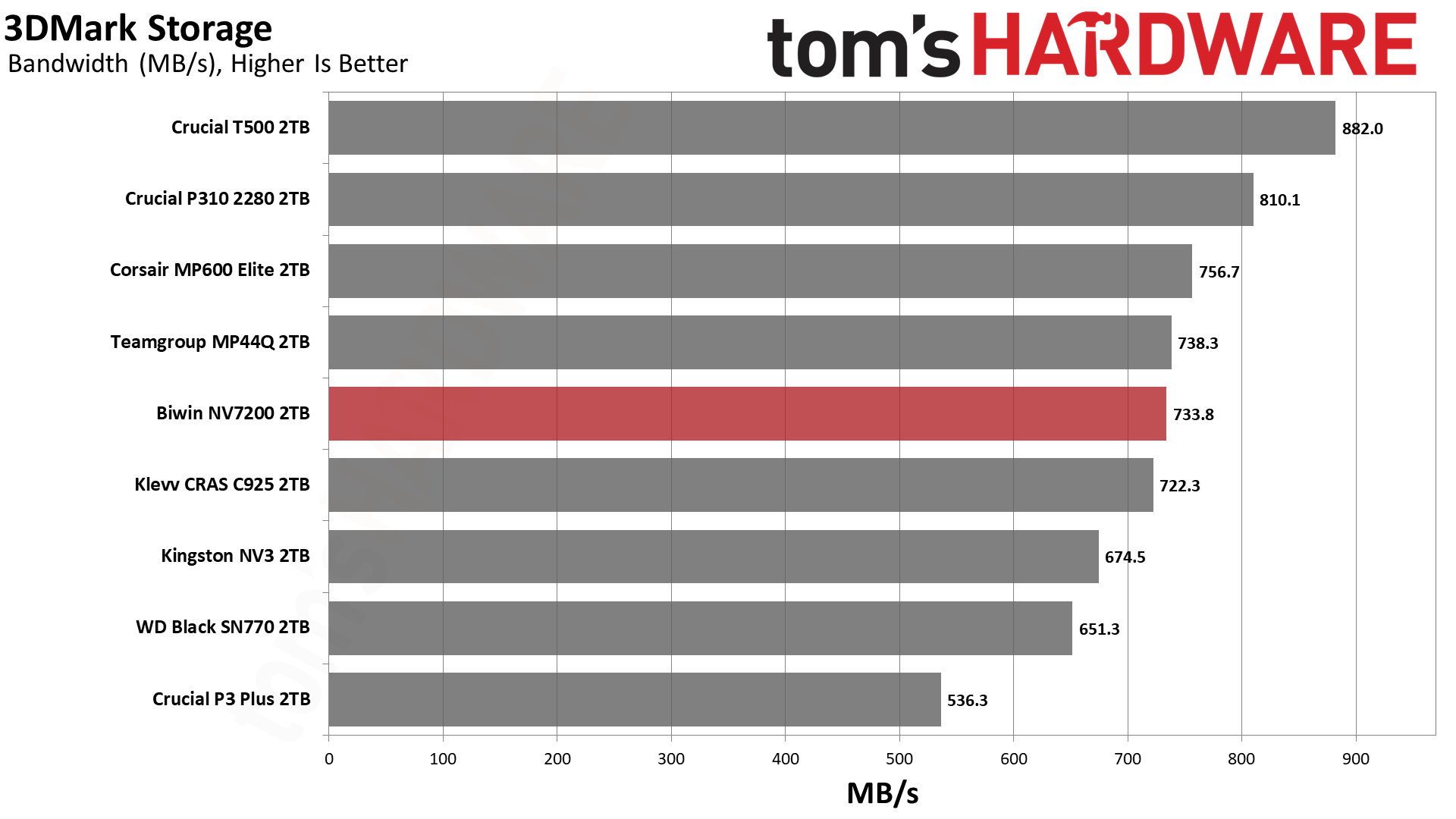
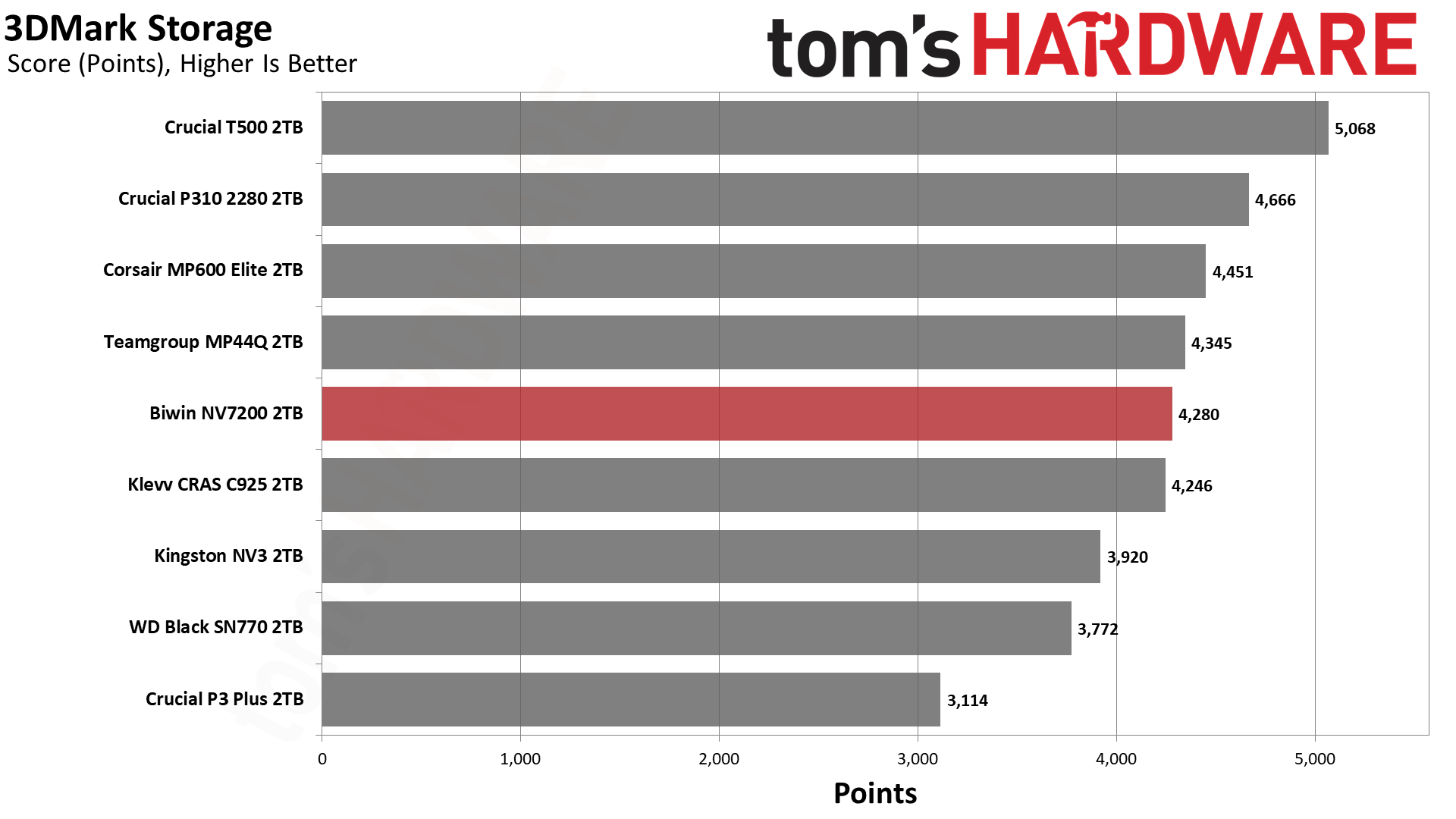

We think the best place to use a budget, QLC-based SSD drive is as a secondary gaming drive. The 3DMark results support that recommendation, with the NV7200 falling in the middle of the pack but doing better than many popular budget drives like the NV3, Black SN770, and P3 Plus. It also matches the MP44Q, as expected, with the same hardware, and the TLC-based CRAS C925. The only drive we’d really put above it would be the P310, which, at the moment, is more expensive.
To put things into perspective, compare the NV7200’s 42µs latency to the Crucial P3's 60µs. 30% more responsiveness by going from Gen 3 to Gen 4, and that’s with the P3 being essentially a Gen 4 drive limited to PCIe 3.0. By no means are we suggesting you upgrade for games, as the P3 and many lesser drives are plenty fast, but if you’re coming from an HDD or SATA SSD, it’s probably worth skipping over PCIe 3.0 drives.
Get Tom's Hardware's best news and in-depth reviews, straight to your inbox.
Trace Testing — PCMark 10 Storage Benchmark
PCMark 10 is a trace-based benchmark that uses a wide-ranging set of real-world traces from popular applications and everyday tasks to measure the performance of storage devices. The results are particularly useful when analyzing drives for their use as primary/boot storage devices and in work environments.



In a pinch, the NV7200 could work as a primary drive, too. Its PCMark 10 performance is higher than that of some TLC-based drives, such as the Black SN770, MP600 Elite, and CRAS C925. That extra bandwidth helps, and further, this QLC flash is well-optimized for normal workloads. You’re not going to see the ugly side of QLC in most cases. Still, the P310 and T500 are very impressive here. The NV7200 is great for a laptop, but so are those two, and the T500 has TLC flash and DRAM. If you’re trying to save some money, though, the NV7200 will serve you well.
Console Testing — PlayStation 5 Transfers
The PlayStation 5 is capable of taking one additional PCIe 4.0 or faster SSD for extra game storage. While any 4.0 drive will technically work, Sony recommends drives that can deliver at least 5,500 MB/s of sequential read bandwidth for optimal performance. In our testing, PCIe 5.0 SSDs don’t bring much to the table and generally shouldn’t be used in the PS5, especially as they may require additional cooling. Check our Best PS5 SSDs article for more information.
Our testing utilizes the PS5’s internal storage test and manual read/write tests with over 192GB of data both from and to the internal storage. Throttling is prevented where possible to see how each drive operates under ideal conditions. While game load times should not deviate much from drive to drive, our results can indicate which drives may be more responsive in long-term use.
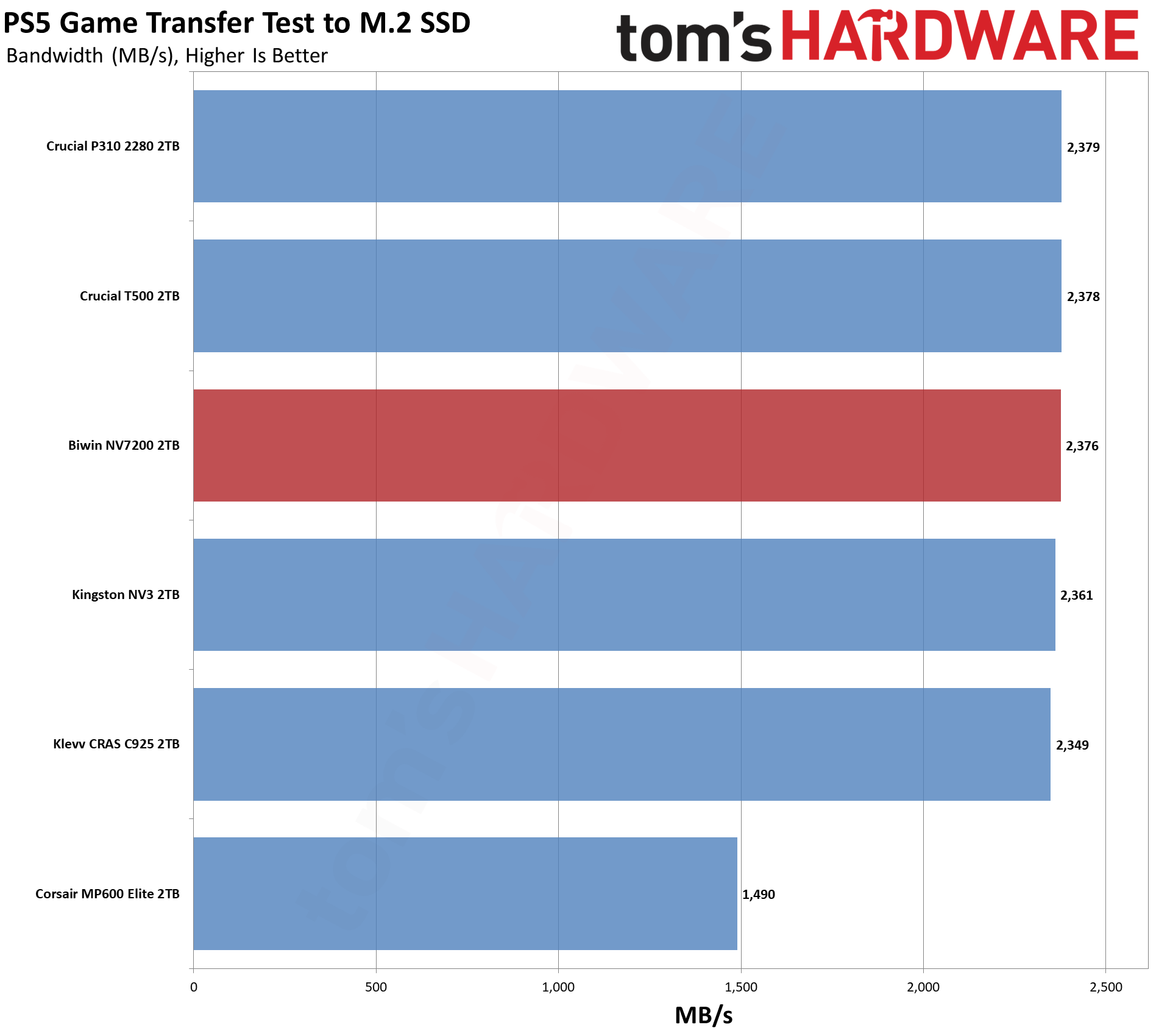
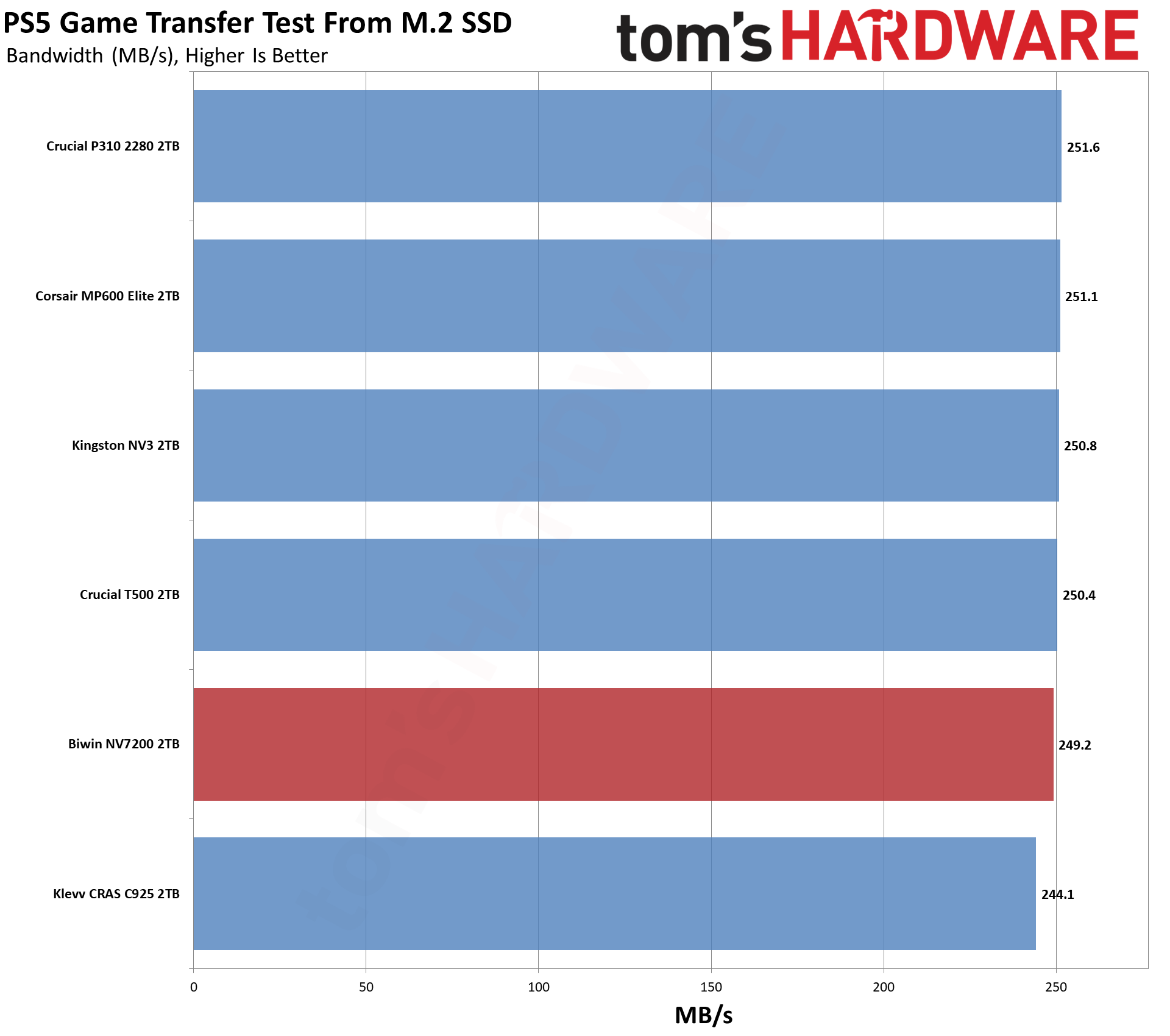
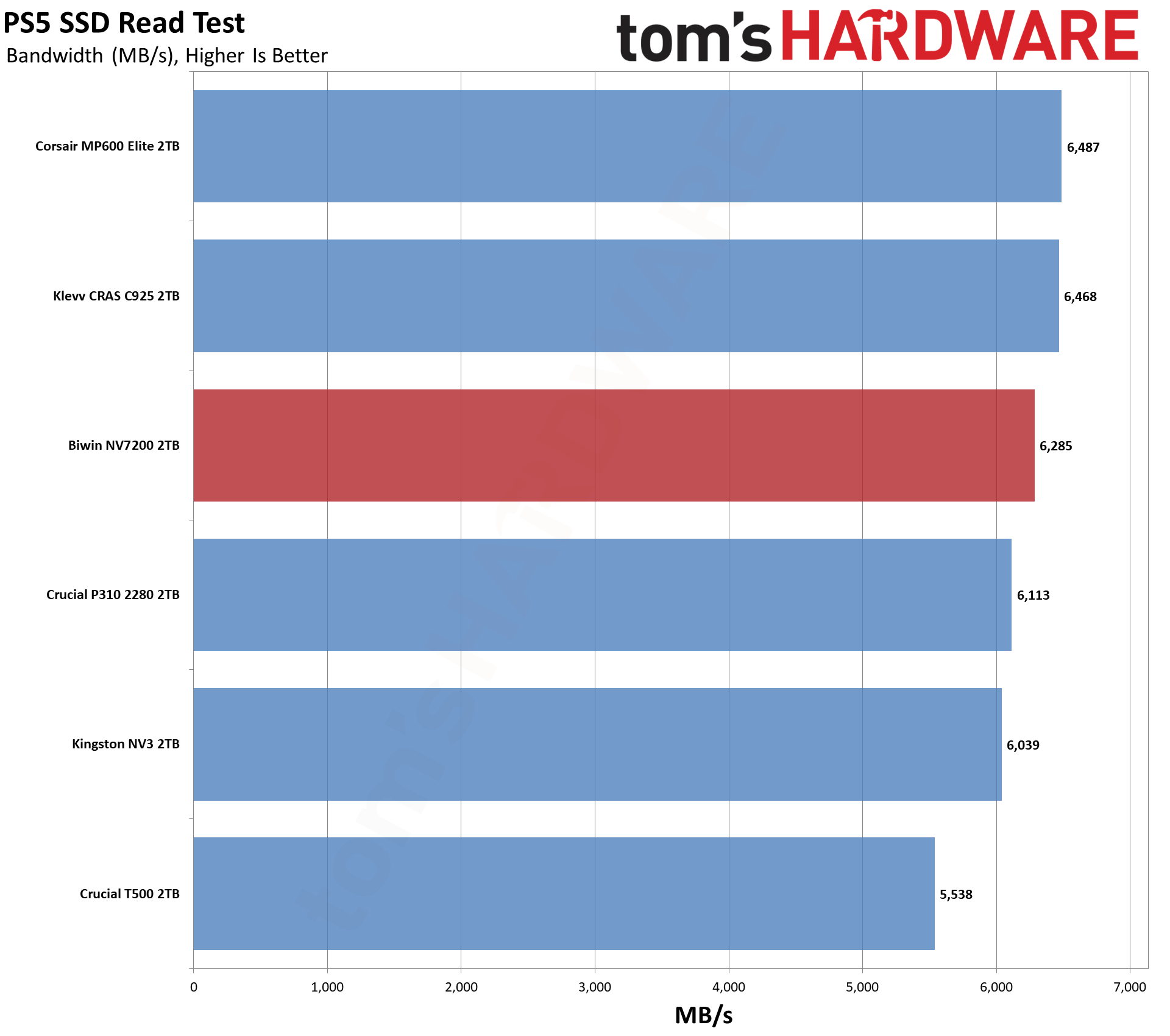
QLC drives are great for the PS5, too. You’re mostly engaging in reads, and any writes will usually be slower than what’s possible on a PC. Pretty much any halfway-decent PCIe 4.0 drive is more than enough to deliver a great experience. That leans in the NV7200’s favor because, as we stated above, it’s very often priced well, and would be one of the best choices at 2TB specifically.
Transfer Rates — DiskBench
We use the DiskBench storage benchmarking tool to test file transfer performance with a custom, 50GB dataset. We write 31,227 files of various types, such as pictures, PDFs, and videos to the test drive, then make a copy of that data to a new folder, and follow up with a reading test of a newly-written 6.5GB zip file. This is a real world type workload that fits into the cache of most drives.

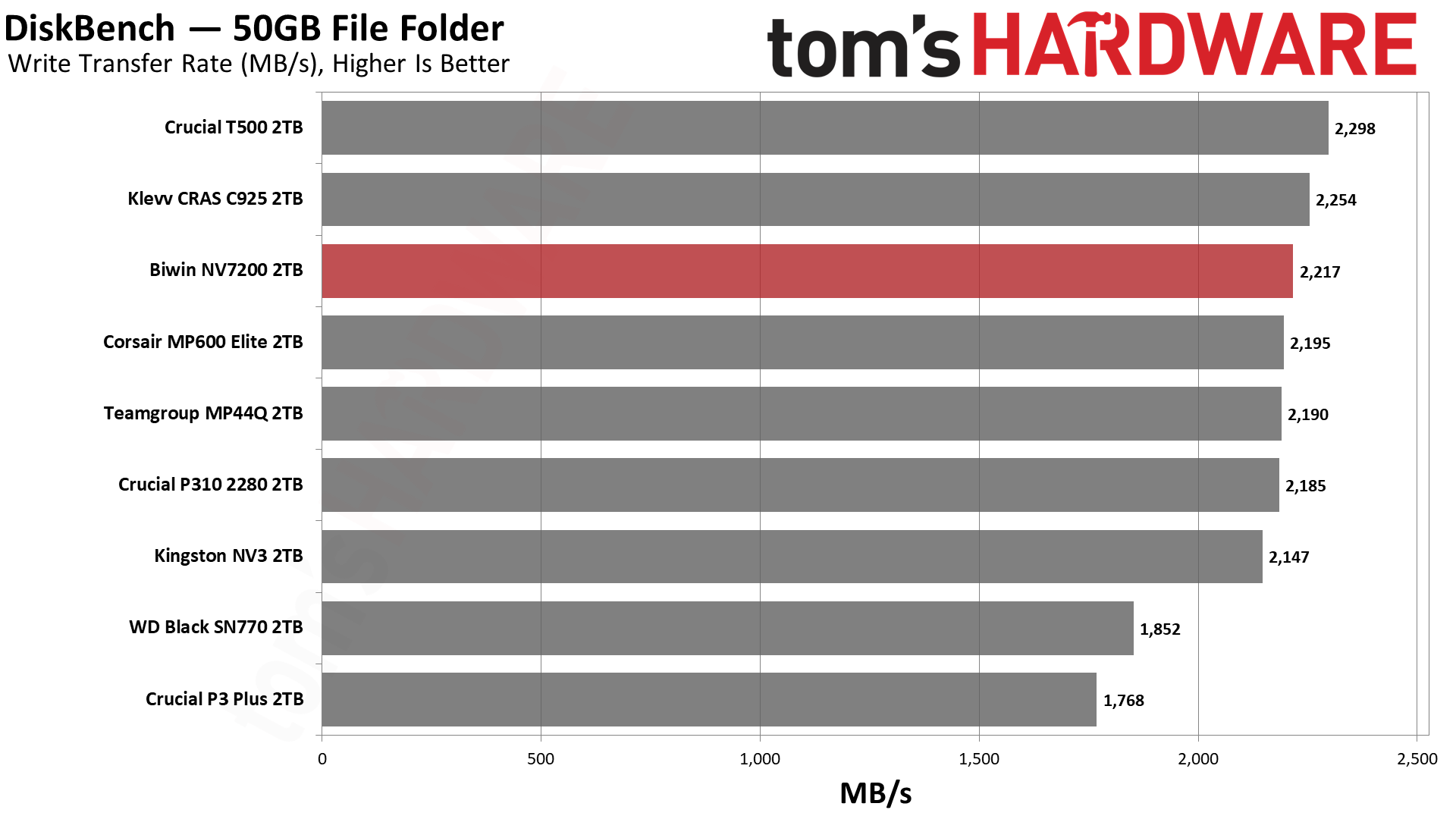
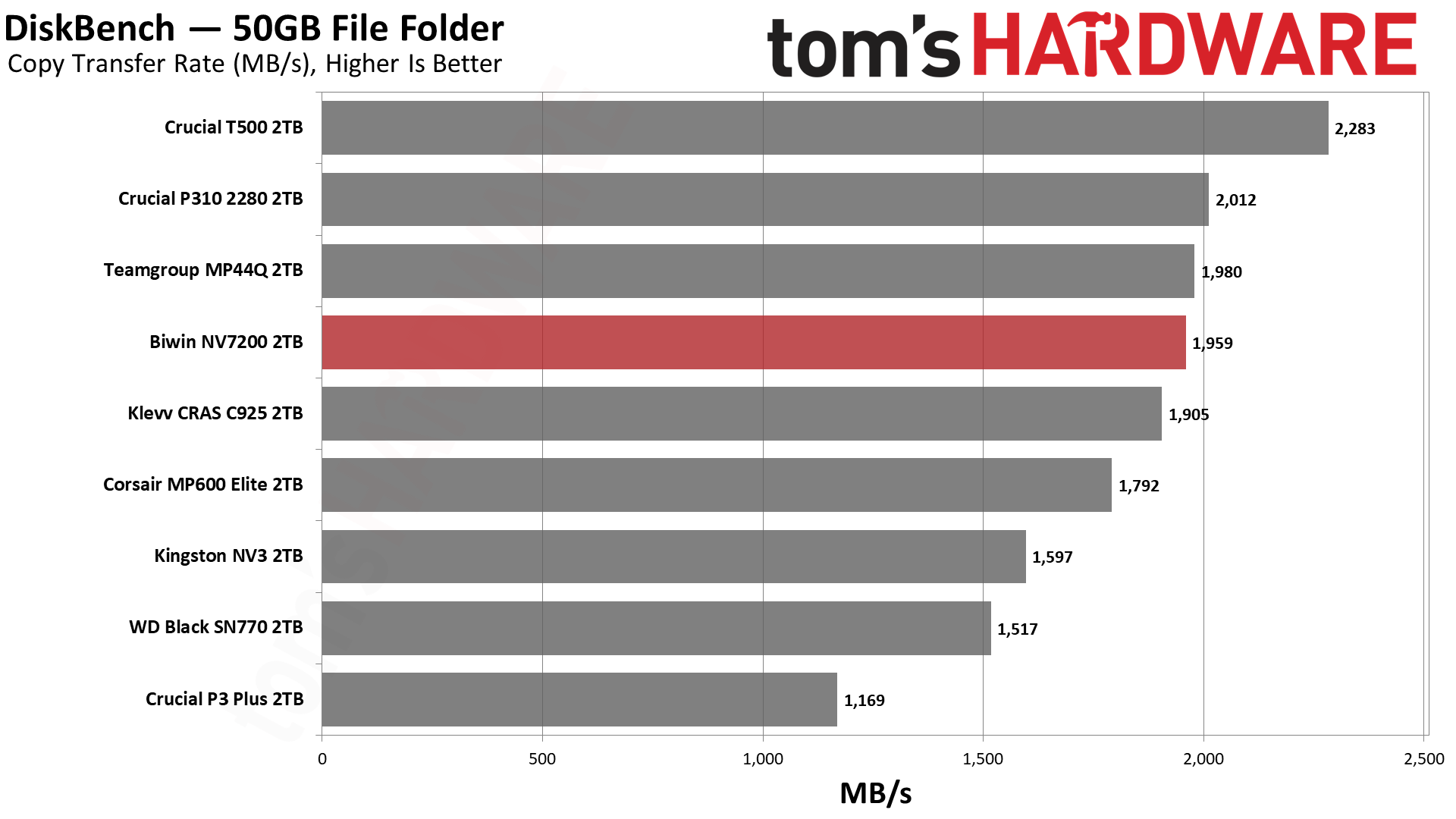
What about file transfers? For anything that fits in the pSLC cache, the NV7200 is plenty fast. It again proves itself viable by beating some TLC-based drives and performing near the top, aside from the T500’s singular dominance. If your transfers are typically smaller and spaced apart over time, this is good enough.
Synthetic Testing — ATTO / CrystalDiskMark
ATTO and CrystalDiskMark (CDM) are free and easy-to-use storage benchmarking tools that SSD vendors commonly use to assign performance specifications to their products. Both of these tools give us insight into how each device handles different file sizes and at different queue depths for both sequential and random workloads.
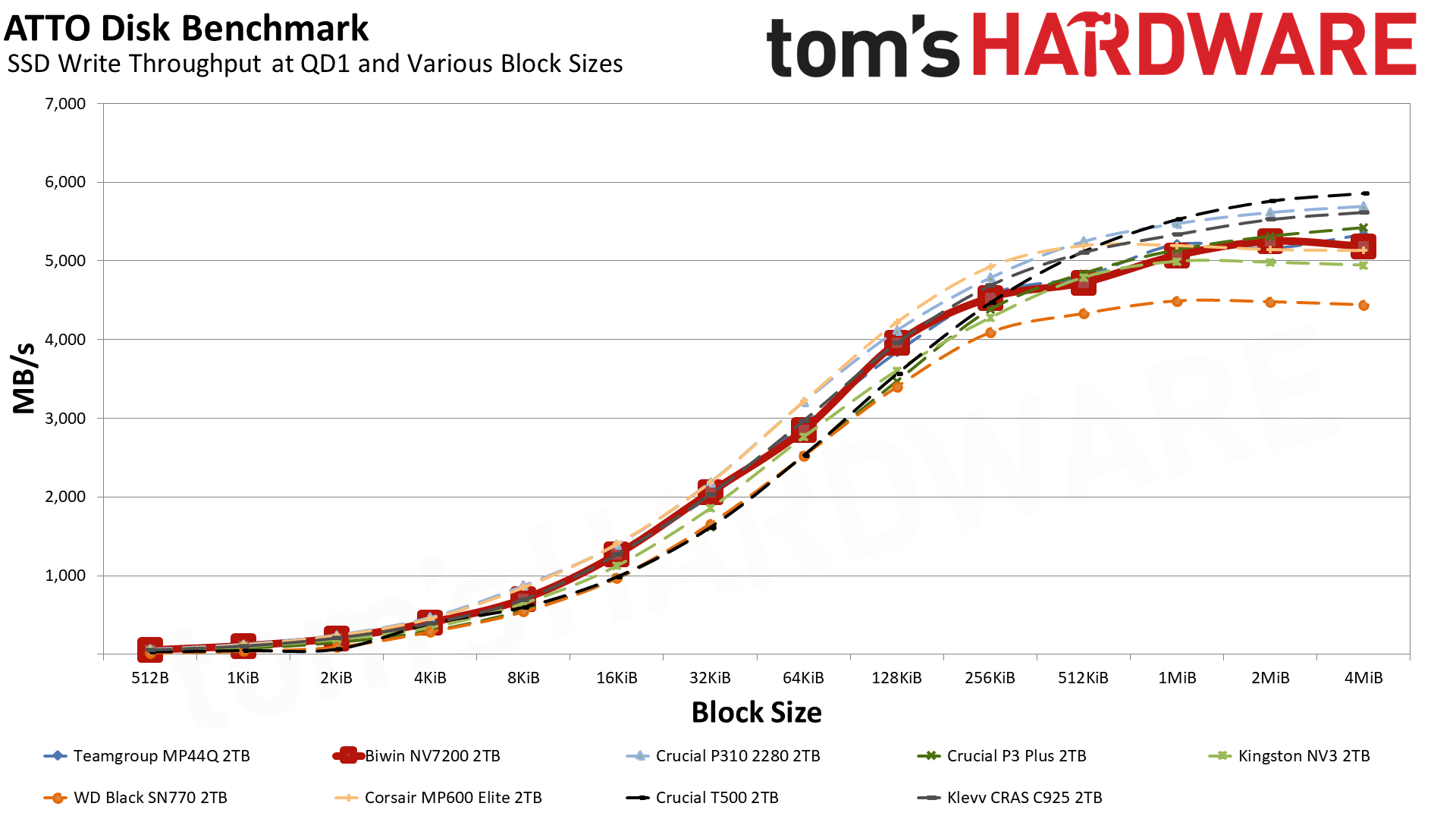
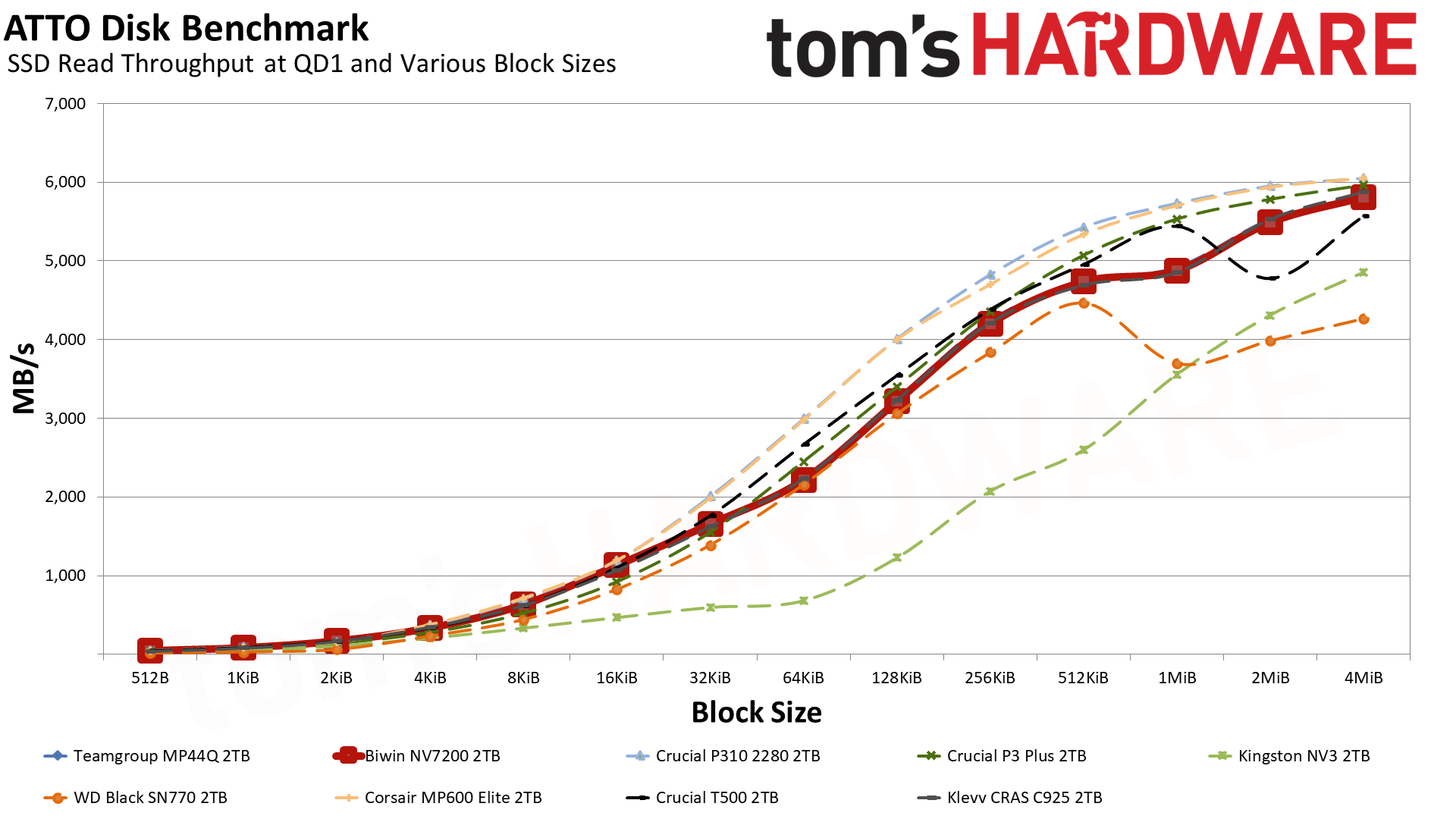
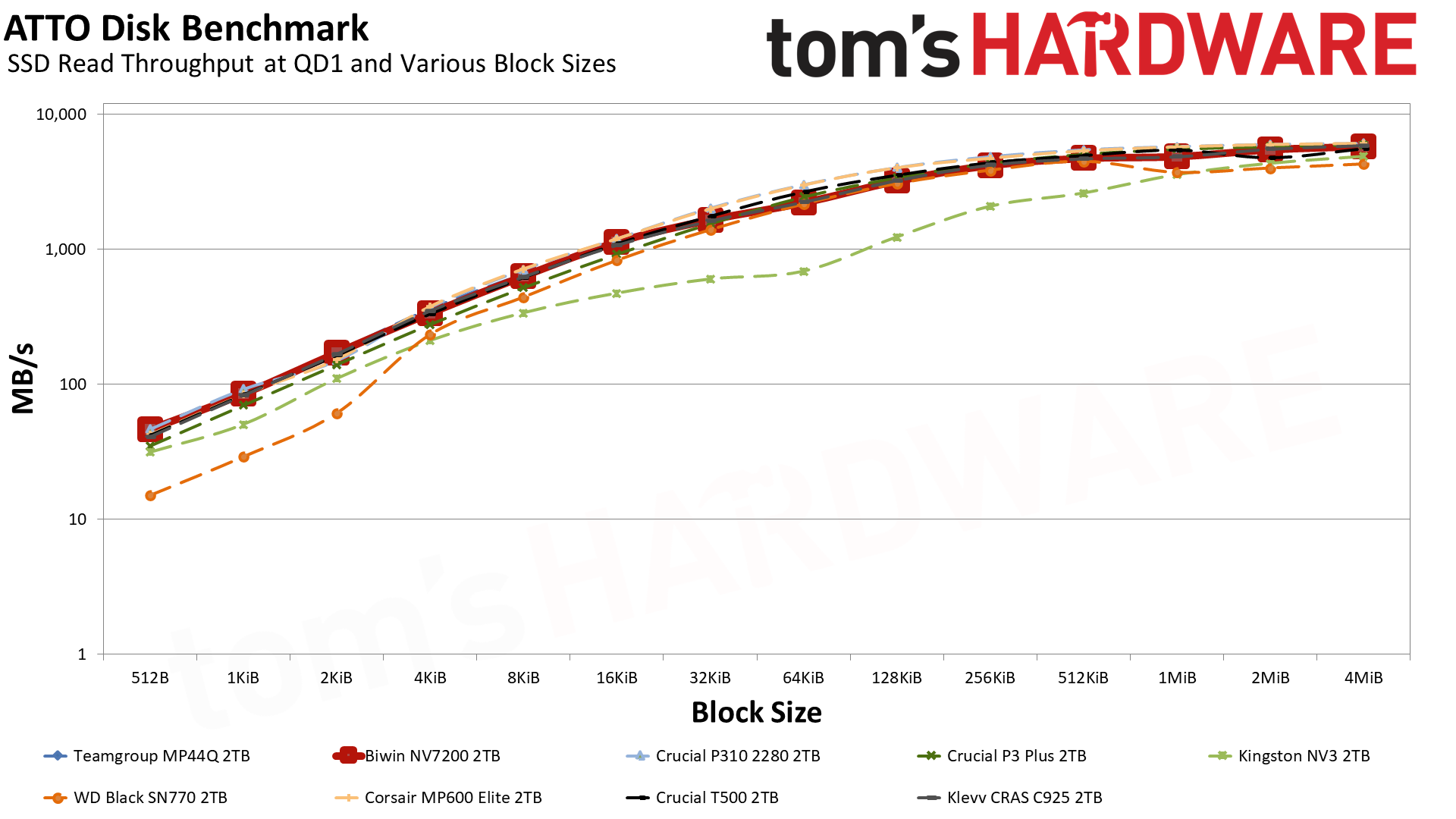

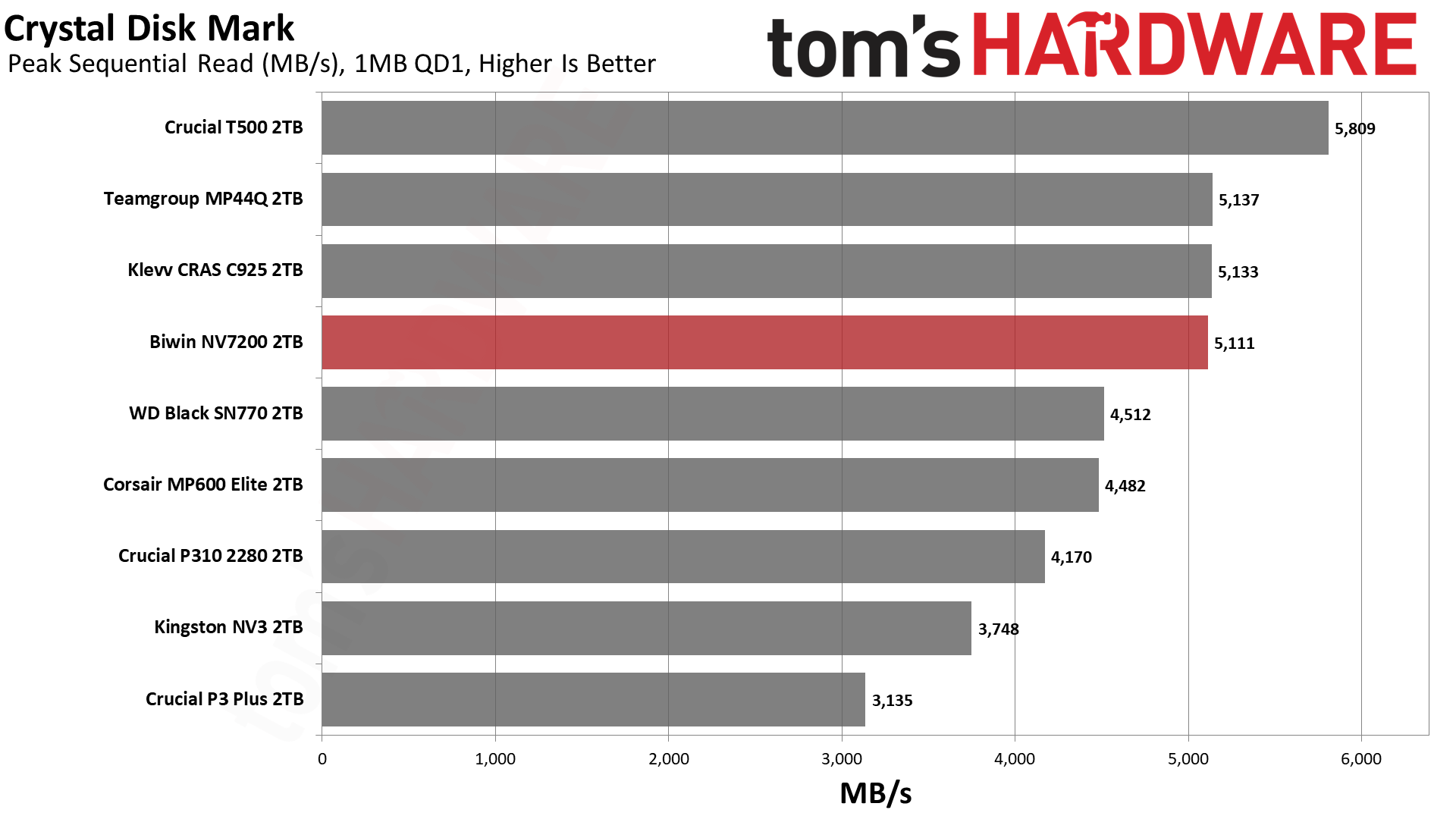
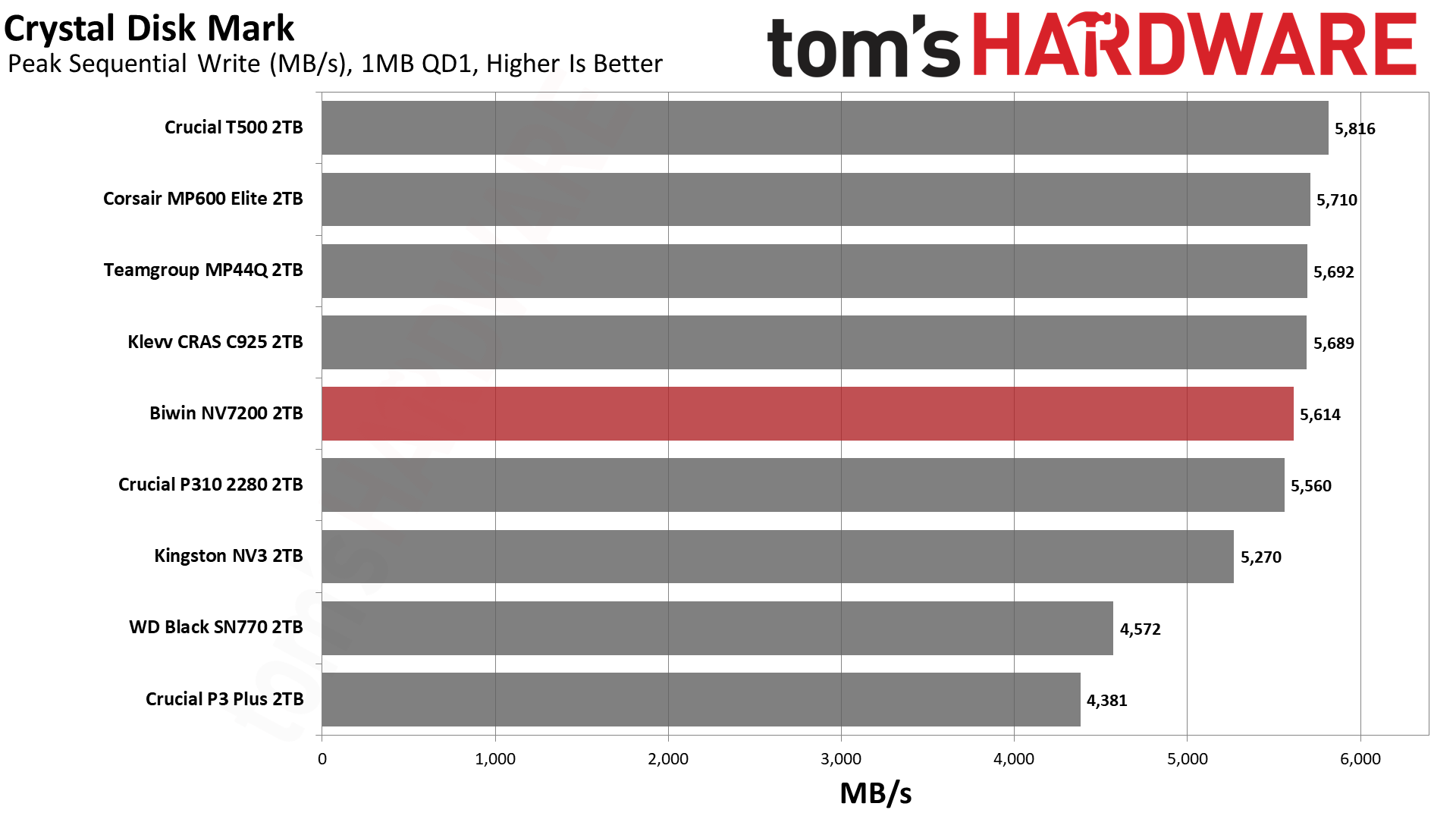
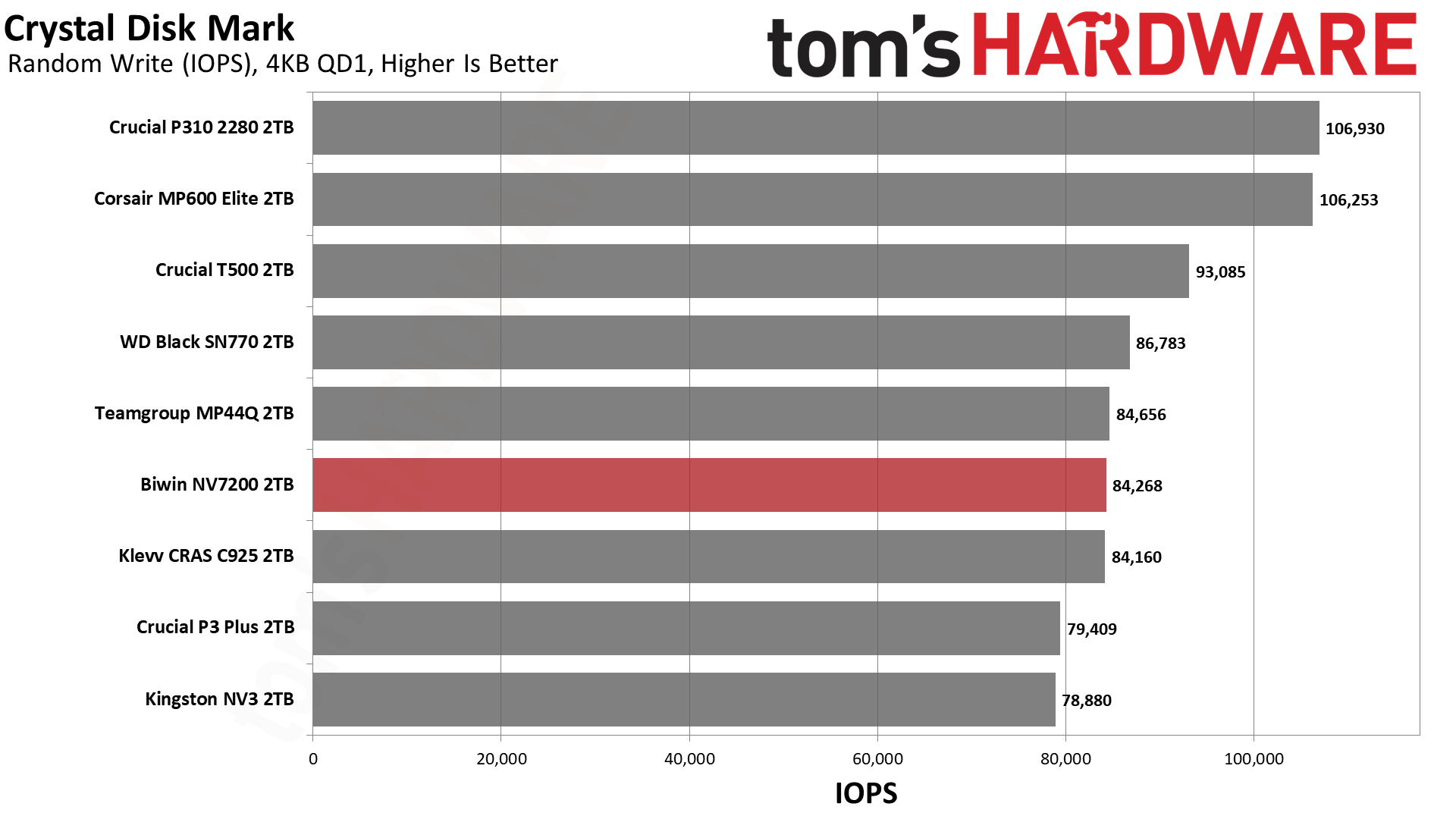
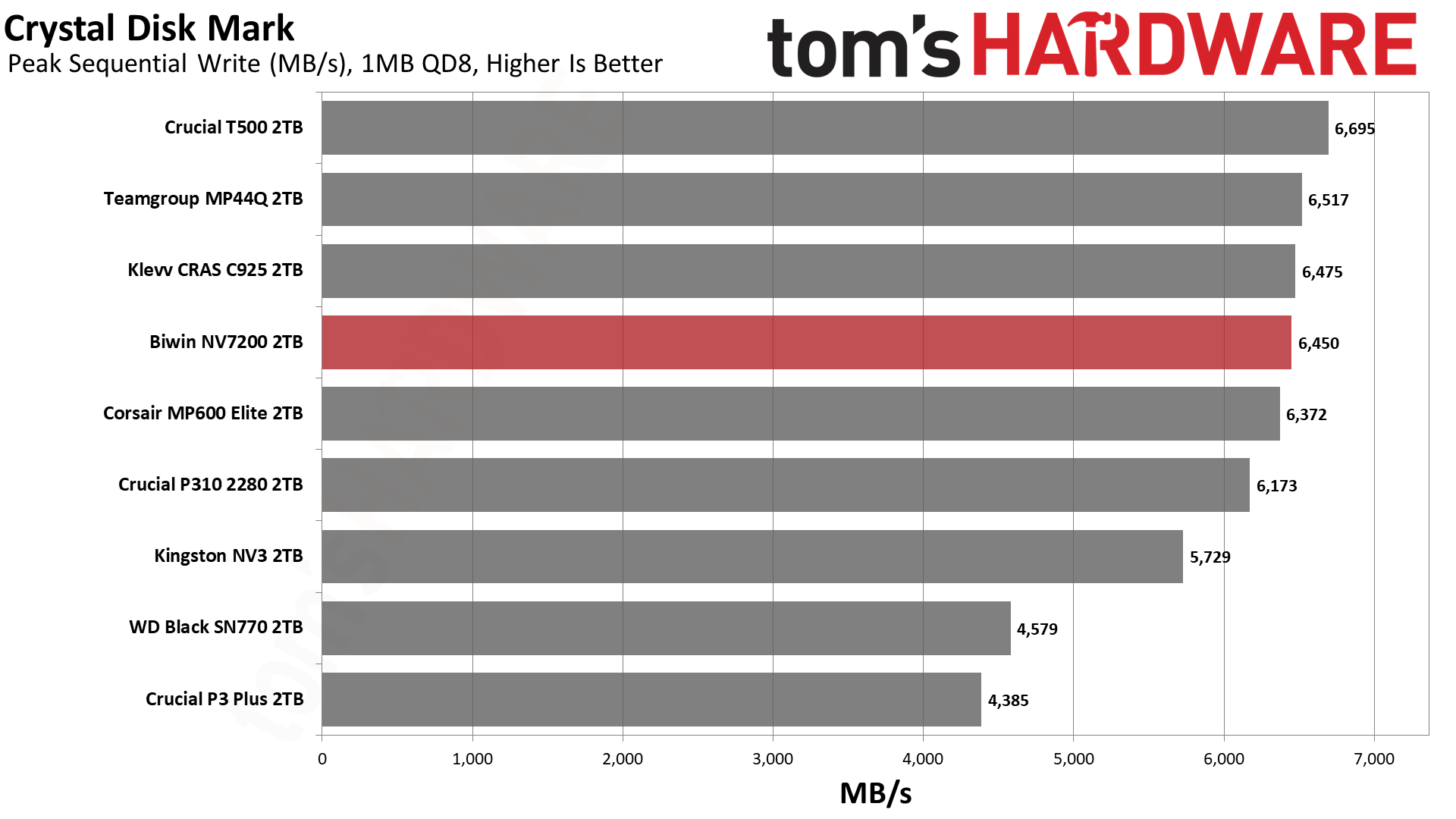
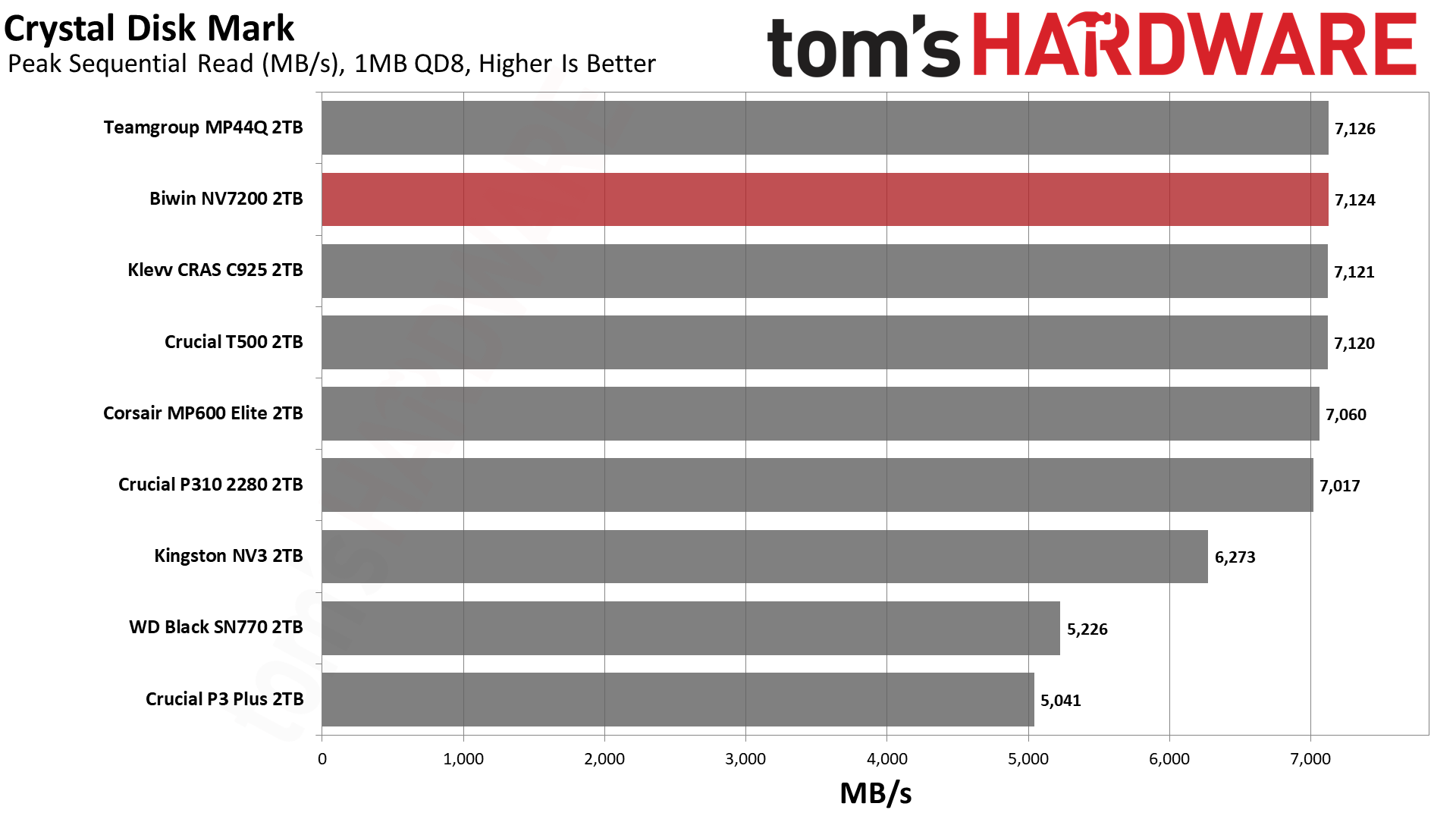
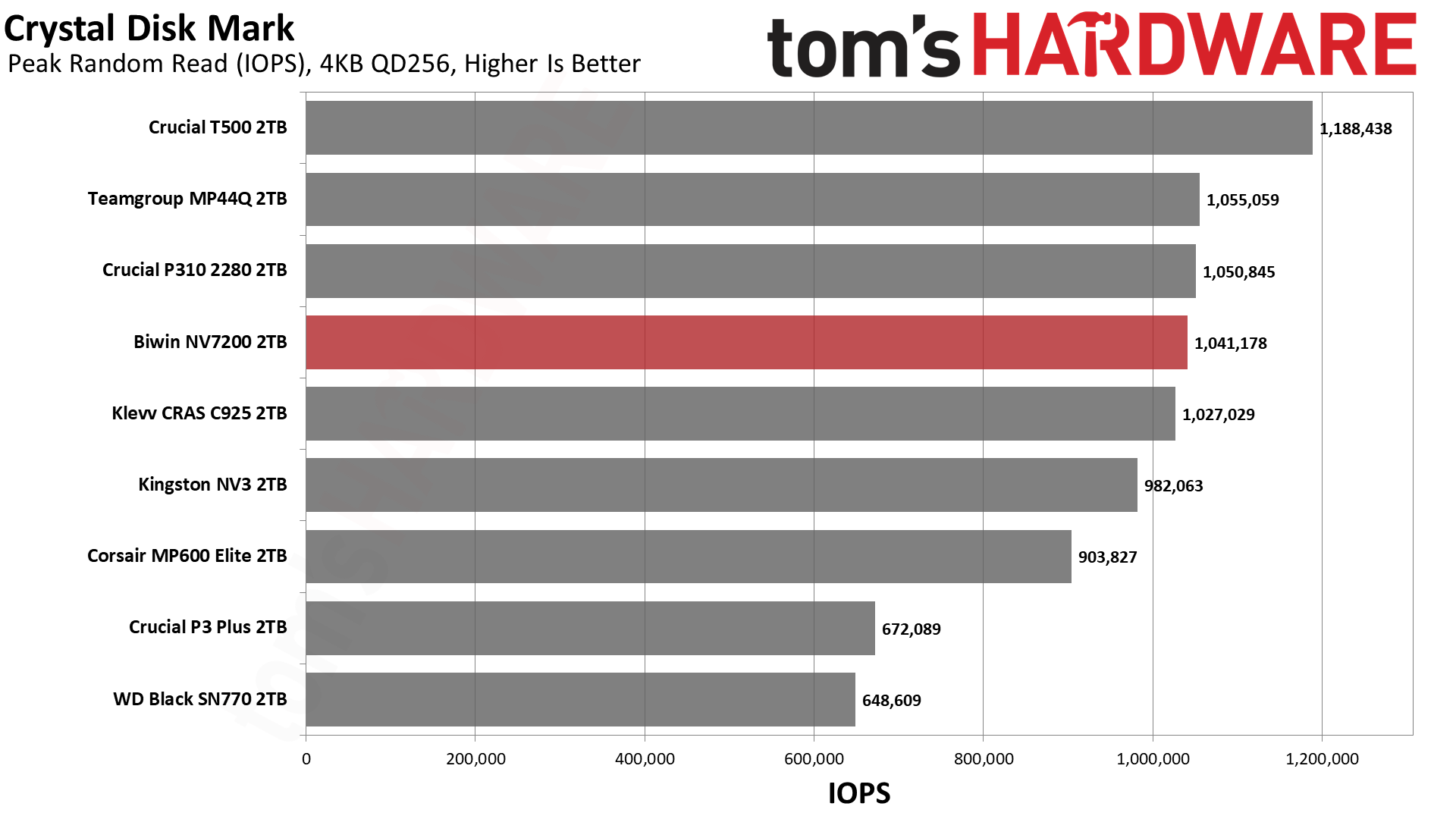



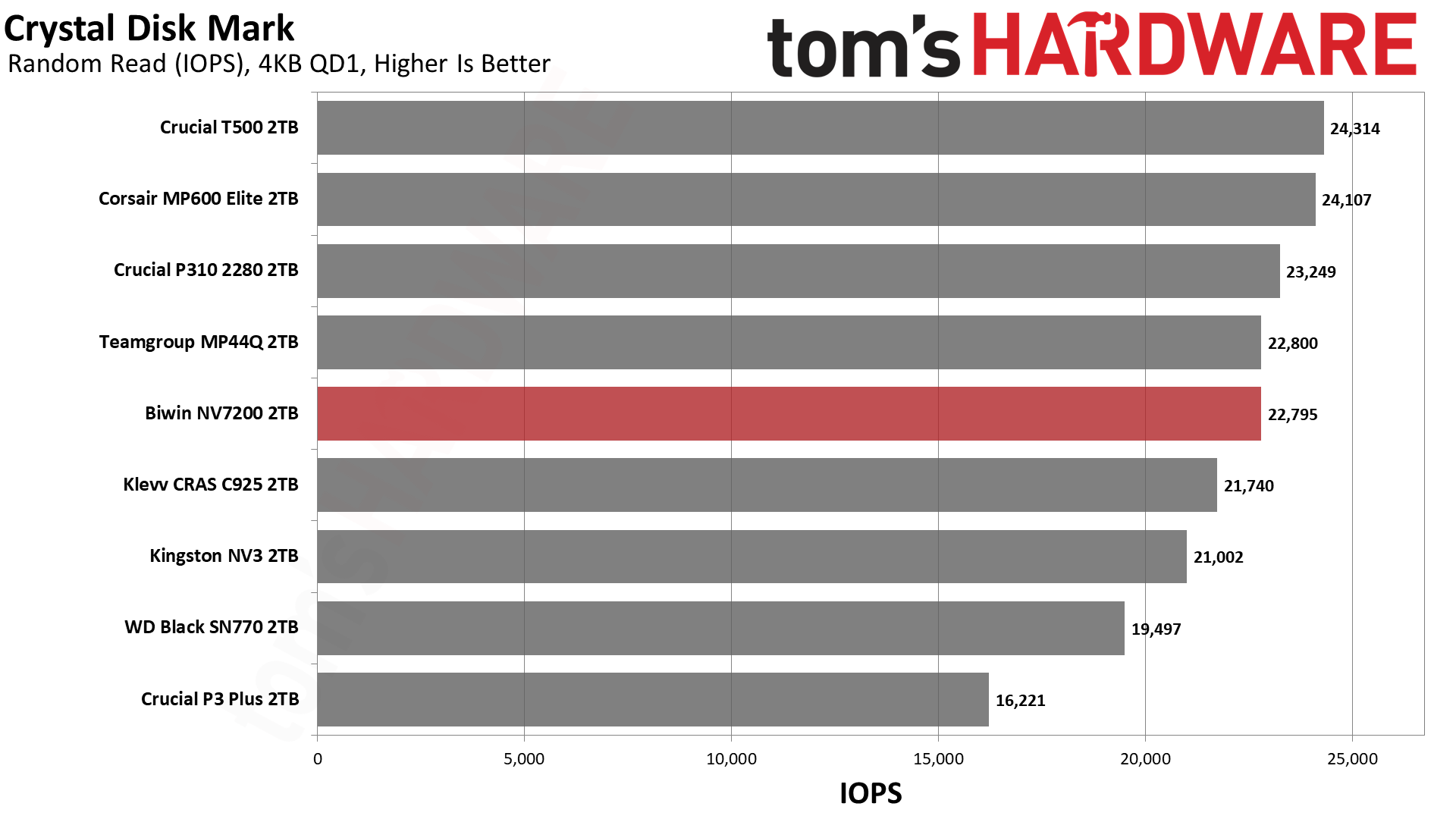
We first look at ATTO to identify any areas where the hardware acts unusually. With the NV7200, we see a dip in 1MiB reads and some minor turbulence for larger-block writes. For reads, we see similar dips for the CRAS C925 and TeamGroup MP44Q, which use the same Maxio controller. We can guess this is a controller thing and not from the flash, as the CRAS C925 is TLC-based. For writes, the MP44Q matches the NV7200, but the CRAS C925 scores higher, in which case the flash does make a difference. TLC can achieve a higher maximum write throughput than QLC even in pSLC mode. This is because the actual cell size or volume may be less for QLC, which is optimized for density. Less volume means that higher sensitivity is required on average, which translates to more latency. This is only something you will notice in edge cases, though.
In CrystalDiskMark, the NV7200 performs quite well in sequential tests. It matches the better drives if we ignore the T500. Notably, it performs well even with sequential writes, regardless of queue depth. It’s also faster than the P310 with QD1 reads in a real-world workload. Sequential performance as a whole is good. Random, 4KB performance; however, it hits a snag or two. The P310 is much more responsible with writes and beats the NV7200 with 4KB QD1 reads, too. This isn’t really an issue, as the drive still beats many budget favorites like the Black SN770 and completely dominates the older QLC P3 Plus. We see nothing here to prevent the NV7200 from being used for whatever you’d like.
Sustained Write Performance and Cache Recovery
Official write specifications are only part of the performance picture. Most SSDs implement a write cache, which is a fast area of pseudo-SLC (single-bit) programmed flash that absorbs incoming data. Sustained write speeds can suffer tremendously once the workload spills outside of the cache and into the "native" TLC (three-bit) or QLC (four-bit) flash. Performance can suffer even more if the drive is forced to fold, which is the process of migrating data out of the cache in order to free up space for further incoming data.
We use Iometer to hammer the SSD with sequential writes for 15 minutes to measure both the size of the write cache and performance after the cache is saturated. We also monitor cache recovery via multiple idle rounds. This process shows the performance of the drive in various states as well as the steady state write performance.
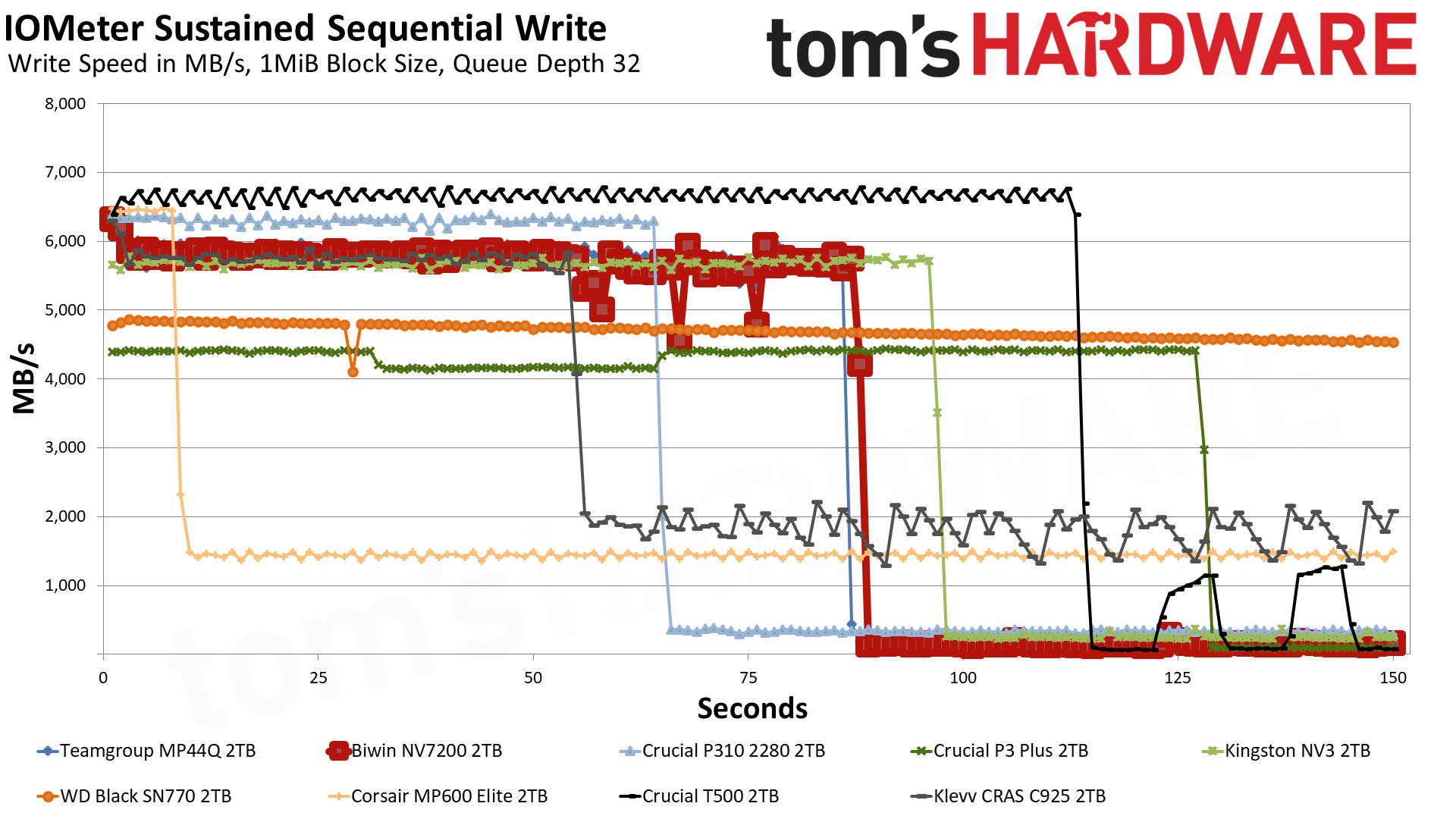
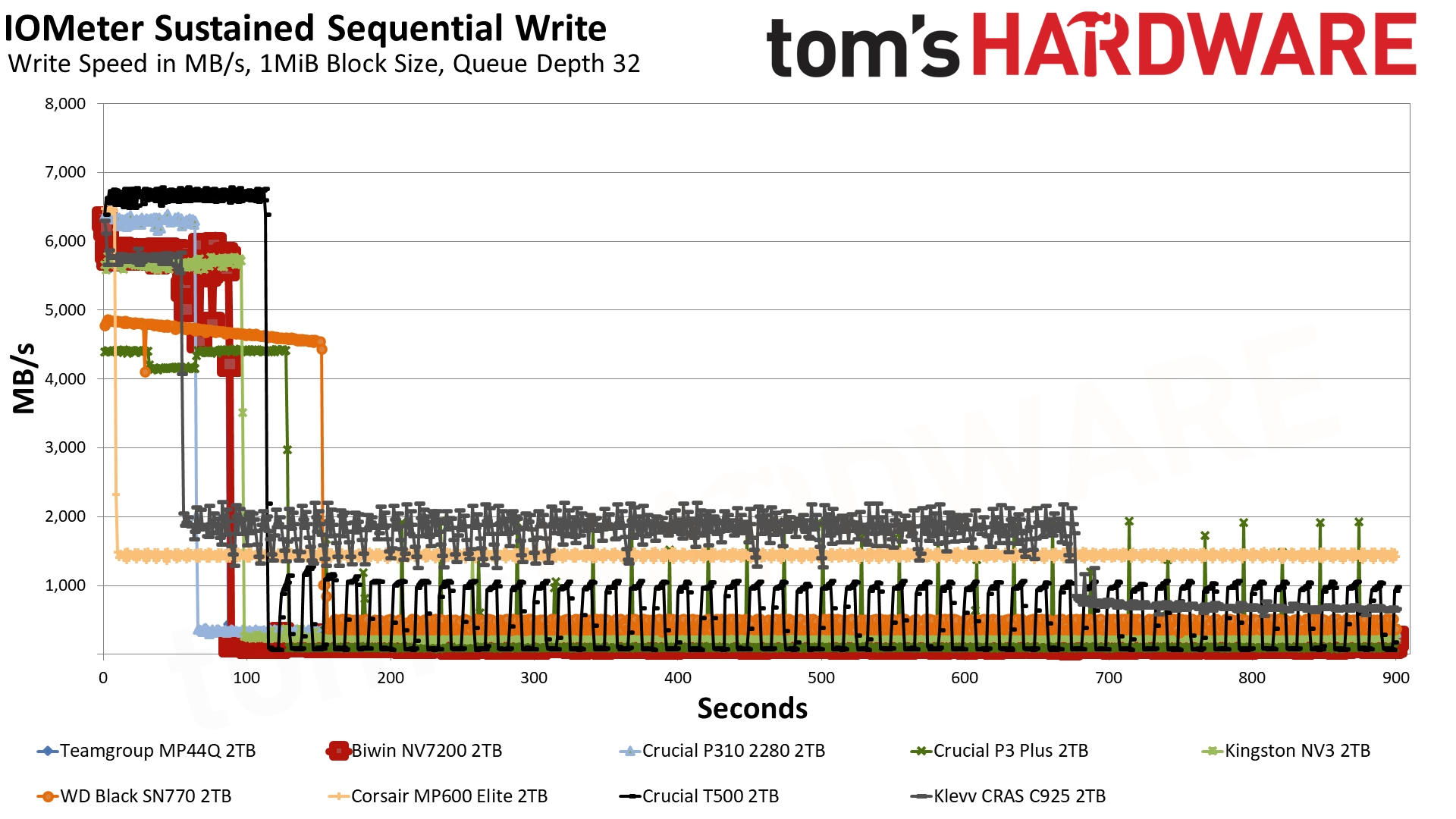
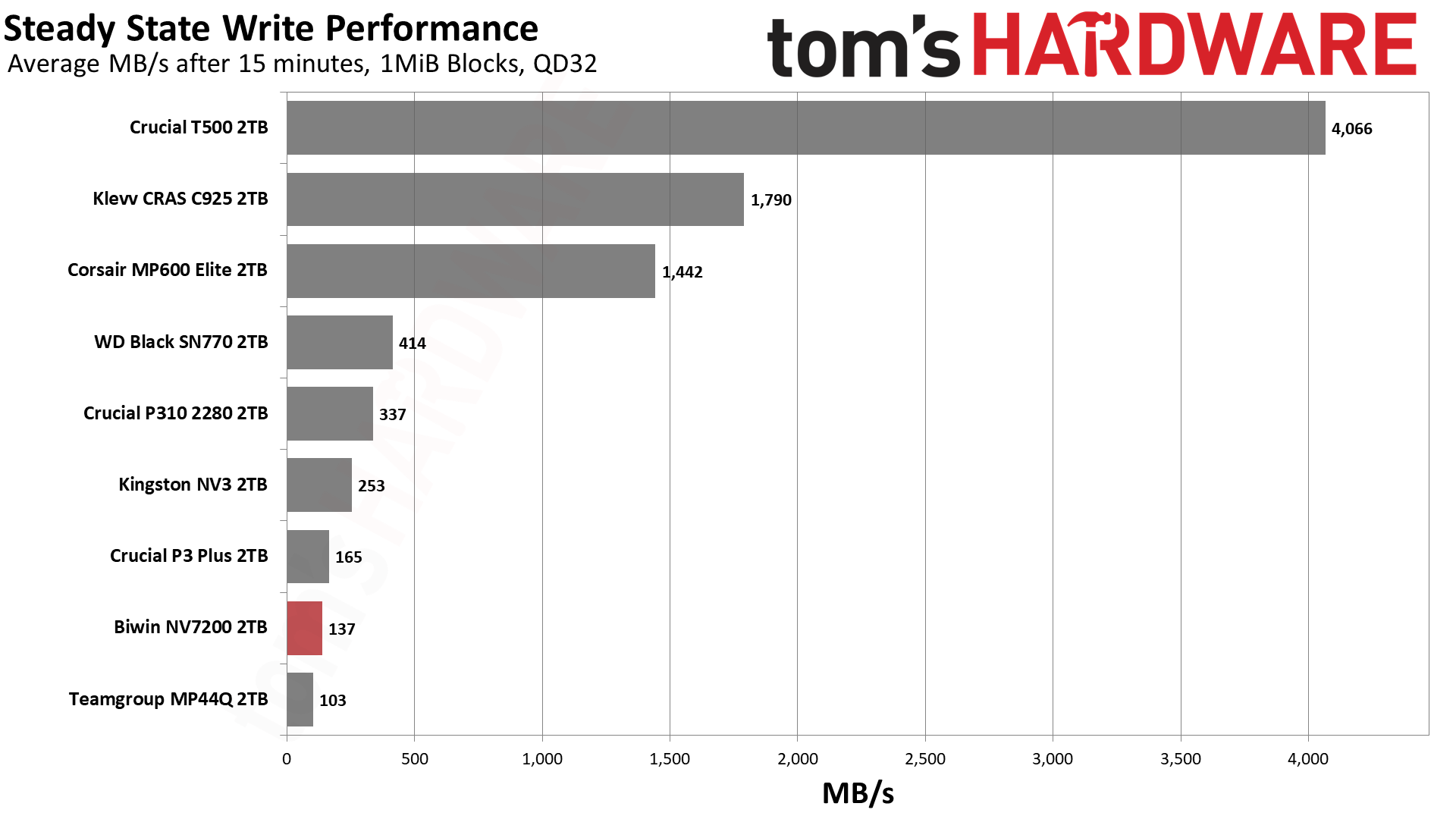
The NV7200 uses QLC flash, so it normally works in a 4-bit mode. The pSLC cache is instead in a single-bit mode, offering much higher performance as the cells are easier to program and read. This transition from 4-bit to 1-bit means that the available capacity on the drive can go down to 25% of the rated capacity, depending on the size of the cache. Drives with weaker inherent performance – ones that are DRAM-less with QLC flash – often hide it by using large caches, which is a double-edged sword because the performance drop outside the cache becomes even worse.
The NV7200 is one such drive, as we can easily see. It writes in the fastest pSLC mode for over 87 seconds at 5.73 GB/s with a cache of around 500GB. Once the cache is full, the drive is forced to write to the native QLC flash at much lower speeds. These speeds are lower than the flash’s normal performance range because the drive is forced to fold – this is the compacting of four pSLC blocks into one QLC block, requiring extra writes that don’t involve incoming data. The 2TB NV7200 is pegged at around 137 MB/s in this mode, but folding tends to be inconsistent and increases latency, making for a poor user experience. It’s best not to ever get into this mode by avoiding large writes.
Power Consumption and Temperature
We use the Quarch HD Programmable Power Module to gain a deeper understanding of power characteristics. Idle power consumption is an important aspect to consider, especially if you're looking for a laptop upgrade as even the best ultrabooks can have mediocre stock storage. Desktops may be more performance-oriented with less support for power-saving features, so we show the worst-case.
Some SSDs can consume watts of power at idle while better-suited ones sip just milliwatts. Average workload power consumption and max consumption are two other aspects of power consumption but performance-per-watt, or efficiency, is more important. A drive might consume more power during any given workload, but accomplishing a task faster allows the drive to drop into an idle state more quickly, ultimately saving energy.
For temperature recording we currently poll the drive’s primary composite sensor during testing with a ~22°C ambient. Our testing is rigorous enough to heat the drive to a realistic ceiling temperature.
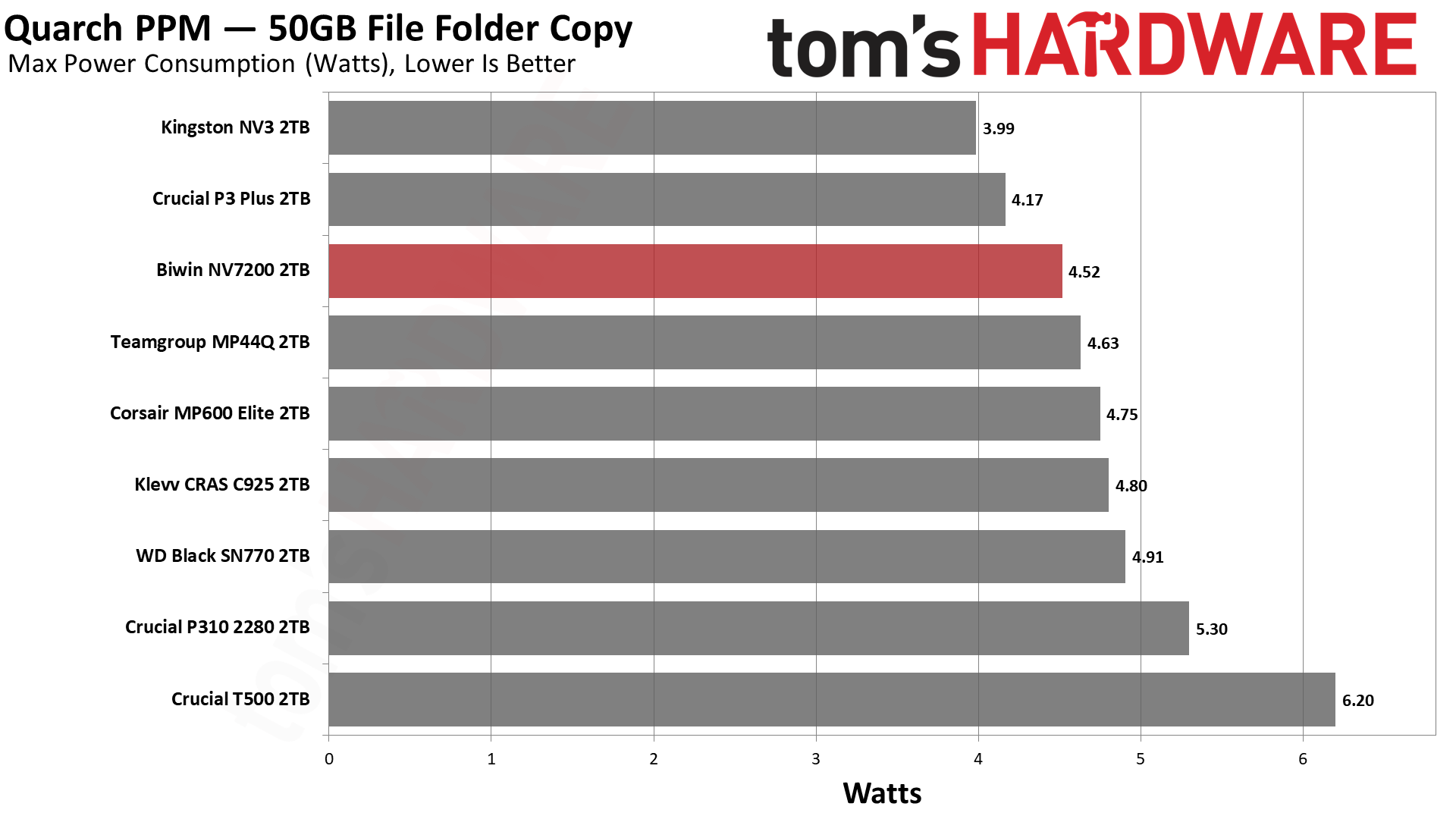
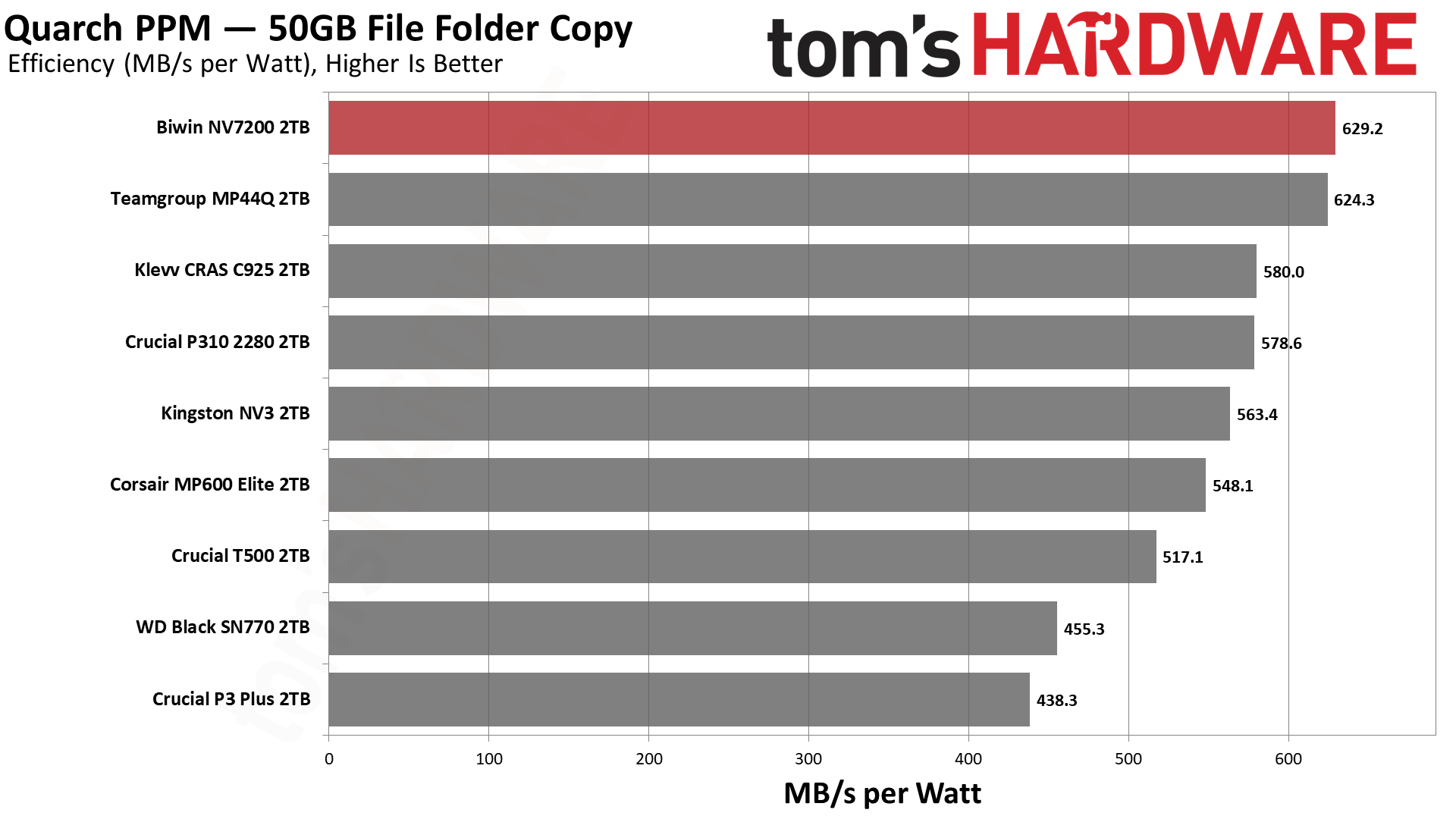


Power consumption is certainly one bright spot for the NV7200. It beats every other drive on the list in power efficiency, bringing in numbers that would have been awesome last generation. We’ve come to expect more these days, but even so, the drive is impressive against budget favorites like the P3 Plus and Black SN770. We have no real complaints. It also peaked at only 4.52W, almost 2W below its power-state maximum, though that is, in part, extra headroom for the 4TB SKU. The drive also ran exceptionally cool for us, the peak temperature being so far below threshold throttling that we could easily recommend it for any system. Our only caveat is that this controller acts as a hotspot, so we suggest keeping the graphene label in place to ensure it does its job.
Test Bench and Testing Notes
CPU | |
Motherboard | |
Memory | |
Graphics | Intel Iris Xe UHD Graphics 770 |
CPU Cooling | |
Case | |
Power Supply | |
OS Storage | |
Operating System |
We use an Alder Lake platform with most background applications such as indexing, Windows updates, and anti-virus disabled in the OS to reduce run-to-run variability. Each SSD is prefilled to 50% capacity and tested as a secondary device. Unless noted, we use active cooling for all SSDs.
Biwin NV7200 Bottom Line
Readers will certainly be curious about why we are giving the Biwin NV7200 a slightly higher score than the recently-reviewed Acer FA200 and TeamGroup MP44Q. After all, these three drives have the same hardware and are all manufactured by Biwin. Well, it’s pretty simple: a budget drive should, you know, be affordable. Too often, we have fantastic QLC-based drives like the Crucial P310 and SanDisk WD Blue SN5100, which offer higher performance but simply aren’t priced well enough to shake off TLC-based contenders.
The NV7200, at the time of review, has some of the best GB/$ prices around at the three capacities that matter. Given the looming storm clouds of higher SSD and flash prices, it's one of the best buys at the moment. So our score is contingent on this pricing – future readers should know to compare all of the drives with similar hardware to see which is cheapest at any given time.
Let’s talk more about what this drive has to offer. In its pSLC mode, which should be the case 99% of the time in normal use, performance is good or better everywhere it matters. It’s great for laptops, desktops, the PS5, etc. The graphene heatspreader label does its job as the drive is power-efficient and cool-running on the whole. If you need to upgrade an old system or want to add a second drive for more space, the NV7200 is an easy budget choice. We’d recommend the drives listed just above if pricing shifts in the future, though, with the FA200 and MP44Q on level, the P310 and SN5100 being better at the same price, and older drives like the Crucial P3 Plus being all but ignorable at this point. It’s worth going for the full 7 GB/s in today’s market, in our opinion.
If, on the other hand, you’re looking at performance on a budget, you probably want to go with a TLC-based drive like the TeamGroup MP44 or Lexar NM790. The problem here is that a newer drive – the SanDisk WD Black SN7100 – has been taking the rest to task because it’s priced so effectively, especially at 4TB. And, as with the slower QLC drives, the TLC-based WD Black SN770 is starting to show its age. You really want to invest in the newest hardware with prices being so close together, even if it only means relatively small gains in performance and/or power efficiency. One reason for this is that older budget drives have been, are, or will be swapping in inferior hardware, and it’s better to be safe with something more consistent.
For those looking for DRAM, there’s the Crucial T500 if you want that four-channel love, maybe on a laptop. If you can handle more power or want PCIe 5.0, well, the NV7200 should only be on your list for the PS5 or as a secondary drive. It’s perfect for storing files and games. We think it could work as the sole drive for light workloads, say on a laptop, but if your aspirations and budget are bigger, that really leaves this only as a cost-effective way to get more capacity. Frankly, the drive is still insanely fast by last-generation standards, and if prices are truly destined to go up, then this is a good pickup during the upcoming holiday sales. Biwin is clearly ambitious about getting a foothold in storage with its own products, which means there’s an opportunity to get proven hardware at a discount right now.
MORE: Best SSDs
MORE: Best External SSDs
MORE: Best SSD for the Steam Deck

Shane Downing is a Freelance Reviewer for Tom’s Hardware US, covering consumer storage hardware.
